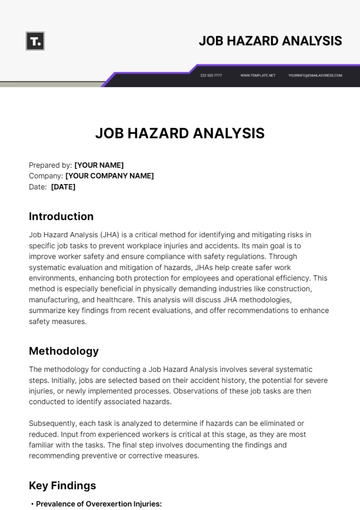Free Financial Compliance Compliance Analysis

A. Introduction and Objectives
The purpose of this Financial Compliance Analysis is to meticulously evaluate [Your Company Name]'s adherence to the pertinent financial regulations and laws governing its operations in the United States. This analysis is crucial in identifying and mitigating any risks of non-compliance. It serves not only to safeguard the company against legal and financial repercussions but also to uphold its reputation for integrity and ethical practices in the financial industry.
The primary objectives of this analysis are to systematically review [Your Company Name]'s existing compliance framework, assess the effectiveness of current compliance policies and procedures, and ensure alignment with the latest federal and state financial regulations. This process includes a detailed examination of internal controls, risk management strategies, and compliance training programs. Ultimately, the goal is to reinforce a culture of compliance within the organization, ensuring all business activities are conducted in accordance with legal and regulatory standards.
B. Regulatory Framework
This section outlines the regulatory landscape within which [Your Company Name] operates. Understanding and navigating the complex web of financial regulations is pivotal for ensuring full compliance. We focus on key federal and state laws, industry-specific guidelines, and international standards where applicable, providing a comprehensive view of the regulatory requirements affecting our operations.
Federal Laws and Regulations
We adhere to major federal financial regulations such as the Dodd-Frank Wall Street Reform and Consumer Protection Act, the Sarbanes-Oxley Act, and the Bank Secrecy Act. These laws govern financial reporting, consumer protection, anti-money laundering, and other critical financial aspects.
State-Specific Regulations
In addition to federal laws, we comply with state-level regulations that may vary depending on the state in which we operate. This includes state securities laws, usury laws, and other financial practice regulations.
Industry Guidelines and Standards
We follow guidelines set by financial industry bodies such as the Financial Industry Regulatory Authority (FINRA) and the Securities and Exchange Commission (SEC). These standards ensure best practices in areas like trading, brokerage, and financial advisory services.
International Compliance Standards (if applicable)
For operations that cross national borders, compliance with international financial standards and regulations, such as the International Financial Reporting Standards (IFRS) and anti-money laundering global norms, is also ensured.
C. Risk Assessment
In this section, we undertake a comprehensive risk assessment to identify and evaluate potential compliance risks faced by [Your Company Name]. This process is essential for proactive risk management, allowing us to prioritize and address areas of high risk effectively. The following table categorizes these risks, assesses their potential impact, and estimates the likelihood of occurrence.
Risk Category | Potential Impact | Likelihood of Occurrence |
|---|---|---|
Non-Compliance with Federal Regulations | Legal penalties, financial losses, reputational damage | Moderate to High |
Inadequate Internal Controls | Financial discrepancies, fraud, operational inefficiencies | Low to Moderate |
Insufficient Employee Training | Unintentional regulatory violations, ineffective compliance practices | Moderate |
Emerging Regulatory Changes | Non-compliance due to outdated policies, need for constant updates | High |
D. Compliance Policies and Procedures
This section delineates the comprehensive compliance policies and procedures established by [Your Company Name] to ensure consistent adherence to financial regulations and laws. These steps form the backbone of our compliance strategy, aiming to integrate regulatory requirements seamlessly into our daily operations and corporate culture.
Policy Development and Review
Employee Training and Awareness
Compliance Monitoring Systems
Incident Reporting and Management
Continuous Improvement and Feedback Loop
E. Internal Control Systems
The Internal Control Systems section provides a structured overview of the mechanisms [Your Company Name] has in place to ensure financial compliance. These controls are designed to prevent, detect, and correct any irregularities or non-compliance issues. The table below categorizes key internal controls, describes their functions, and identifies the areas they primarily safeguard.
Control Type | Function | Primary Area of Safeguard |
|---|---|---|
Financial Reporting Controls | Ensure accuracy and reliability of financial reporting | Financial Statements, Disclosures |
Operational Controls | Oversee operational processes to ensure efficiency and compliance with policies | Daily Operations, Risk Management |
Compliance Monitoring Controls | Regularly review and verify adherence to legal and regulatory requirements | Legal and Regulatory Compliance |
Information Security Controls | Protect sensitive financial data from unauthorized access and breaches | Data Integrity, Confidentiality |
F. Training and Awareness
Effective training and awareness programs are pivotal in fostering a robust compliance culture within [Your Company Name]. These programs ensure that all employees are informed about the compliance standards and understand their role in maintaining them.
Initial Compliance Training
All new employees undergo comprehensive training on compliance policies, procedures, and relevant laws. This foundational training is crucial for setting expectations and understanding from the start.
Ongoing Education Programs
Regular training sessions are conducted to keep staff updated on any changes in the regulatory landscape and internal policies.
Specialized Training for High-Risk Departments
Departments like finance, legal, and operations receive specialized training tailored to their specific compliance risks and responsibilities.
Awareness Campaigns and Communications
Continuous awareness campaigns, through newsletters, intranet updates, and meetings, keep compliance at the forefront of corporate culture.
Feedback and Improvement Mechanisms
Open channels for employee feedback on training programs are maintained to continuously improve the effectiveness of these initiatives.
G. Monitoring and Reporting
Companies should have mechanisms for ongoing monitoring of compliance. These must facilitate accurate and timely reporting within the organization to support decision-making. Effective monitoring sustains compliance by identifying deviations promptly.
H. Incident Management and Remediation
Whenever compliance breaches happen, the company should have procedures for handling them. These include investigation, reporting incidents, and taking corrective actions. Incidents handling significantly contributes to regulatory compliance and maintaining organizational reputation.
I. Record Keeping and Documentation
Record keeping and documentation are integral components of [Your Company Name]'s compliance framework. Meticulous records ensure transparency and accountability in all financial activities, serving as concrete evidence of compliance with relevant regulations. Our system captures detailed records of all financial transactions, audits, compliance checks, and training sessions. These records are stored securely, ensuring both accessibility for review and protection against unauthorized access.
We adhere to strict guidelines regarding the duration for which different types of records must be retained, in compliance with legal requirements. Regular audits of our record-keeping system help ensure accuracy and completeness. This systematic documentation not only supports regulatory reporting and internal audits but also provides invaluable insights for continuous improvement in our compliance processes.
J. Review and Improvement
At [Your Company Name], the Review and Improvement process is a continuous, integral part of our financial compliance strategy. This process involves regular evaluations of our compliance framework, identifying areas for enhancement, and implementing necessary adjustments. By embracing a dynamic approach, we adapt effectively to evolving regulatory landscapes, refine our internal controls, and reinforce our commitment to maintaining the highest standards of financial compliance.
K. Conclusion
In conclusion, this Financial Compliance Analysis embodies [Your Company Name]'s steadfast commitment to upholding the highest standards of financial integrity and regulatory compliance. Through rigorous assessment, effective policies, and continuous improvement, we strive to not only meet but exceed regulatory expectations, ensuring the long-term success and credibility of our organization.
The proactive approach detailed in this analysis demonstrates our dedication to fostering a culture of compliance and transparency. By continuously adapting to regulatory changes and enhancing our internal controls, we safeguard our company's reputation and contribute to the stability and integrity of the broader financial system.
- 100% Customizable, free editor
- Access 1 Million+ Templates, photo’s & graphics
- Download or share as a template
- Click and replace photos, graphics, text, backgrounds
- Resize, crop, AI write & more
- Access advanced editor
Streamline your financial compliance process with Template.net's Financial Compliance Analysis Template. This indispensable tool is fully editable and customizable, ensuring it fits your specific needs. Designed for seamless use, it's easily editable in our Ai Editor Tool, making compliance management more efficient and effective for your business.





























